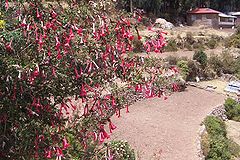
Cantuta
Encyclopedia

Flowering plant
The flowering plants , also known as Angiospermae or Magnoliophyta, are the most diverse group of land plants. Angiosperms are seed-producing plants like the gymnosperms and can be distinguished from the gymnosperms by a series of synapomorphies...
found in the high valleys of the yungas
Yungas
The Yungas is a stretch of forest along the eastern slope of the Andes Mountains from southeastern Peru through central Bolivia. It is a transitional zone between the Andean highlands and the eastern forests. Like the surrounding areas, it has characteristics of the Neotropic ecozone...
. It is the national flower of Peru
Peru
Peru , officially the Republic of Peru , is a country in western South America. It is bordered on the north by Ecuador and Colombia, on the east by Brazil, on the southeast by Bolivia, on the south by Chile, and on the west by the Pacific Ocean....
and one of two national flowers of Bolivia
Bolivia
Bolivia officially known as Plurinational State of Bolivia , is a landlocked country in central South America. It is the poorest country in South America...
, the other being the Patujú. The Bolivian national flower is in fact a particular variety of Cantuta, the "Kantuta Tricolor" which has red petals, a yellow floral tube and a green calyx
Sepal
A sepal is a part of the flower of angiosperms . Collectively the sepals form the calyx, which is the outermost whorl of parts that form a flower. Usually green, sepals have the typical function of protecting the petals when the flower is in bud...
, reflecting the colors of the national flag
Flag of Bolivia
The current flag of Bolivia was originally adopted by Bolivia in 1851. The state flag and ensign is a horizontal tricolor of red, yellow and green with the Bolivian coat of arms in the center...
.
Inca Legend
The Inca legend associated with the Cantuta is the tale of two kings named IllimaniIllimani
Illimani is the highest mountain in the Cordillera Real of western Bolivia. It lies just south of La Paz at the eastern edge of the Altiplano. It is the second highest peak in Bolivia, after Nevado Sajama, and the eighteenth highest peak in South America...
and Illampu
Illampu
Illampú is the fourth highest mountain in Bolivia. It is located in the northern section of the Cordillera Real, part of the Andes, east of Lake Titicaca. It lies just north of the slightly higher Ancohuma, near the town of Sorata...
, and their sons. Both kings were powerful and wealthy rulers of a vast country in the Kollasuyo region (today's Bolivia
Bolivia
Bolivia officially known as Plurinational State of Bolivia , is a landlocked country in central South America. It is the poorest country in South America...
n Altiplano
Altiplano
The Altiplano , in west-central South America, where the Andes are at their widest, is the most extensive area of high plateau on Earth outside of Tibet...
), and both had a son they and their people held in great esteem. But as time passed, the kings became irritated at each other's prosperity, and eventually one of them attacked the other.
During the battle, both kings were mortally wounded by their counterpart, and were carried away. On their dying bed, both called their son and had them make the vow to avenge them, even if both sons were opposed to the war in the first place. Bound by their pledge, they prepared and led a second war even though they held no grudge against each other. History repeated, and both sons inflicted a fatal wound to the other.
But instead of harsh words, they generously forgave each other, and asked that their servants place them side by side on the green grass of the battlefield. Then appeared Pachamama
Pachamama
Pachamama is a goddess revered by the indigenous people of the Andes. Pachamama is usually translated as Mother Earth, but a more literal translation would be "Mother world"...
, Goddess of Fertility, who told the young kings before they died that they shouldn't have suffered from their father's unjustified enmity. To punish their dead fathers, their stars fell from the sky, and became the snow covered mountains still named Illimani
Illimani
Illimani is the highest mountain in the Cordillera Real of western Bolivia. It lies just south of La Paz at the eastern edge of the Altiplano. It is the second highest peak in Bolivia, after Nevado Sajama, and the eighteenth highest peak in South America...
and Illampu
Illampu
Illampú is the fourth highest mountain in Bolivia. It is located in the northern section of the Cordillera Real, part of the Andes, east of Lake Titicaca. It lies just north of the slightly higher Ancohuma, near the town of Sorata...
, which are the highest peaks in the region.
The rivers of their snow slowly melting are their tears of regret, and fertilized the valleys. The Cantuta bloomed as a symbol of the people's unity, and bear the two colours of the king's sons (red and yellow), as well as green (standing for hope).

